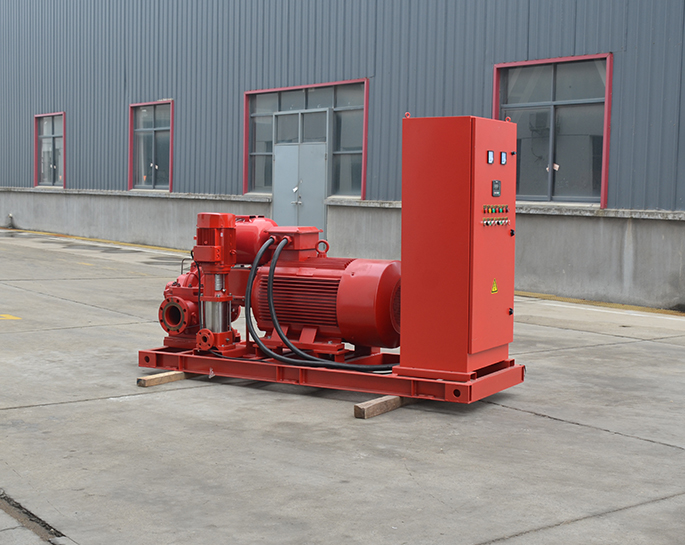What are the considerations for selecting the appropriate size and capacity of an electric fire pump?
Mar 27, 2024
Share:
Selecting the appropriate size and capacity of an electric fire pump is crucial to ensure it can effectively meet the demands of fire protection systems. Several considerations should be taken into account:
1. **Hydraulic Design Requirements**: Understand the hydraulic design requirements of the fire protection system, including the required flow rate (gallons per minute, or GPM) and pressure (pounds per square inch, or PSI) at various points in the system. This information is typically provided by fire protection engineers or outlined in relevant codes and standards (e.g., NFPA 20).
2. **Building Characteristics**: Consider the size, occupancy type, and hazards present in the building or facility being protected. Larger buildings or those with higher fire risks may require larger capacity fire pumps to deliver sufficient water flow and pressure.
3. **System Layout and Design**: Evaluate the layout and design of the fire protection system, including the distribution piping network, elevation changes, friction losses, and system demand factors. These factors influence the total dynamic head (TDH) requirements of the pump.
4. **Available Water Supply**: Assess the available water supply source, such as a municipal water main, reservoir, or dedicated fire water storage tank. The availability and capacity of the water supply influence the selection of the fire pump's capacity.
5. **Water Source Reliability**: Consider the reliability and continuity of the water supply source under various operating conditions, including peak demand, power outages, and system malfunctions. This helps determine whether additional redundancy or backup systems are necessary.
6. **System Demand Variability**: Account for any variability or fluctuations in system demand due to factors such as occupancy levels, process operations, seasonal changes, and future expansion plans. The fire pump should be sized to accommodate peak demand scenarios.
7. **Pump Performance Characteristics**: Evaluate the performance characteristics of available fire pump models, including flow rates, pressure ratings, efficiency, and reliability. Select a pump that can meet the system requirements with an adequate margin of safety.
8. **Electrical Power Supply**: Consider the electrical power supply available for the electric fire pump, including voltage, phase, frequency, and available fault current. Ensure that the selected pump is compatible with the electrical infrastructure and can be reliably powered under all operating conditions.
9. **Space Constraints**: Take into account any space limitations or installation constraints for the fire pump and associated equipment, such as motor room size, piping layout, and clearance requirements. Ensure that the selected pump can be accommodated within the available space.
10. **Regulatory Compliance**: Ensure that the selected fire pump and system design comply with applicable regulatory requirements, codes, and standards, such as NFPA 20, local building codes, and insurance company guidelines.
By carefully considering these factors, fire protection engineers and designers can select the appropriate size and capacity of an electric fire pump to effectively safeguard buildings and occupants against fire hazards. It's essential to consult with qualified professionals and adhere to industry best practices to ensure the reliability and performance of fire protection systems.

1. **Hydraulic Design Requirements**: Understand the hydraulic design requirements of the fire protection system, including the required flow rate (gallons per minute, or GPM) and pressure (pounds per square inch, or PSI) at various points in the system. This information is typically provided by fire protection engineers or outlined in relevant codes and standards (e.g., NFPA 20).
2. **Building Characteristics**: Consider the size, occupancy type, and hazards present in the building or facility being protected. Larger buildings or those with higher fire risks may require larger capacity fire pumps to deliver sufficient water flow and pressure.
3. **System Layout and Design**: Evaluate the layout and design of the fire protection system, including the distribution piping network, elevation changes, friction losses, and system demand factors. These factors influence the total dynamic head (TDH) requirements of the pump.
4. **Available Water Supply**: Assess the available water supply source, such as a municipal water main, reservoir, or dedicated fire water storage tank. The availability and capacity of the water supply influence the selection of the fire pump's capacity.
5. **Water Source Reliability**: Consider the reliability and continuity of the water supply source under various operating conditions, including peak demand, power outages, and system malfunctions. This helps determine whether additional redundancy or backup systems are necessary.
6. **System Demand Variability**: Account for any variability or fluctuations in system demand due to factors such as occupancy levels, process operations, seasonal changes, and future expansion plans. The fire pump should be sized to accommodate peak demand scenarios.
7. **Pump Performance Characteristics**: Evaluate the performance characteristics of available fire pump models, including flow rates, pressure ratings, efficiency, and reliability. Select a pump that can meet the system requirements with an adequate margin of safety.
8. **Electrical Power Supply**: Consider the electrical power supply available for the electric fire pump, including voltage, phase, frequency, and available fault current. Ensure that the selected pump is compatible with the electrical infrastructure and can be reliably powered under all operating conditions.
9. **Space Constraints**: Take into account any space limitations or installation constraints for the fire pump and associated equipment, such as motor room size, piping layout, and clearance requirements. Ensure that the selected pump can be accommodated within the available space.
10. **Regulatory Compliance**: Ensure that the selected fire pump and system design comply with applicable regulatory requirements, codes, and standards, such as NFPA 20, local building codes, and insurance company guidelines.
By carefully considering these factors, fire protection engineers and designers can select the appropriate size and capacity of an electric fire pump to effectively safeguard buildings and occupants against fire hazards. It's essential to consult with qualified professionals and adhere to industry best practices to ensure the reliability and performance of fire protection systems.


.png)
.png)

.png)


